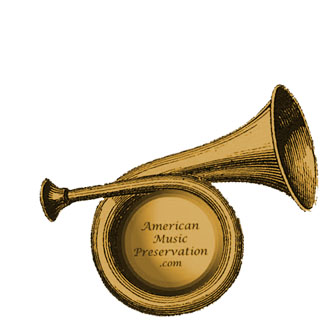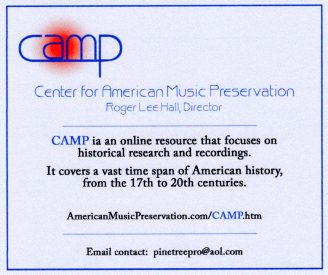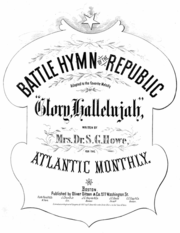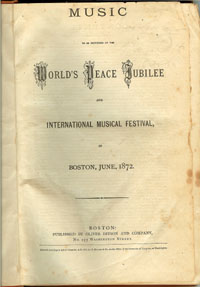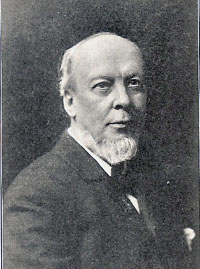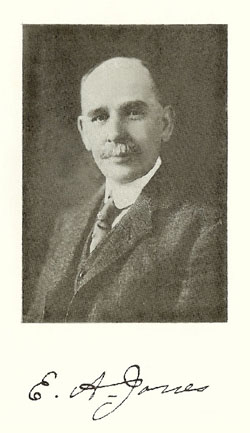
Earlier American Music Timeline
Part Two: 1822 - 1920
Compiled by Roger Lee Hall, musicologist
This timeline covers the century between the first American popular songs to music at the end of World War I and the beginning of the Roaring Twenties.
Part One features music composed and published in America
between 1620 and 1818.These are selective listings and makes no claim to be comprehensive and the emphasis is on vocal music.
They are highlights of key historical events and music composed during these centuries.
Your comments or questions are welcome about the AMT.
Send them to:
American Music History Timeline
Click on these links to read the entries for the...
Please help support the
Order your music items at the
19th century
1822 The Boston Handel and Haydn Society Collection of sacred choruses was first published. It would go on to have 22 editions up until 1858.
1827 First popular American song hit: "The Minstrel's Return from the War," by John Hill Hewitt, called "Father of the American Ballad." This song was believed to have been written in 1825 and published two years later by his brother.
1831 "My Country 'Tis of Thee" (also known as: "America") was first sung at Park Street Church in Boston. The words were written by Samuel Francis Smith and set to the tune of "God Save the King."
1833 The first music instiution was establisahed as Boston Academy of Music by Lowell Mason and William Channing Woodbridge on 8 January.
1835 "Amazing Grace" published to the tune of "New Britain" in William Walker's The Southern Harmony. This is the version most often sung today. It was printed in other tune collections, for example: The Sacred Harp. Also written this year a Shaker dance song was composed by Elder Issachar Bates, "Come Life, Shaker Life" which has become popular in the 20th century.
1838 First music in public schools, begun in Boston and led by music educator, Lowell Mason, who was best known for his many hymns and anthems, including "Nearer My God To Thee" and "Jerusalem, My Glorious Home."
1840 "The Old Arm Chair, A Ballad" a song by Henry Russell, was published in Boston [sheet music cover signed by Russell is shown at left].
1842 The New York Philharmonic founded and is now the oldest orchestra in the U.S.
1845 First American grand opera, Leonora, by William Henry Fry.
1848 Shaker dance song, "Simple Gifts," (also known by its first line: "Tis the gift to be simple") was composed by Elder Joseph Brackett in Alfred, Maine. Later made world famous in several arrangements by Aaron Copland (1900-1990).
1851 Stephen Foster's biggest hit, "Old Folks at Home," was published as sheet music.
1853 Debut of piano virtuoso and composer from New Orleans, Louis Moreau Gottschalk. One of his popular piano pieces was "The Last Hope" which was later arranged in several different hymns, including one composed in the 20th century: "They Who Seek The Throne Of Grace" (Op. 9, No. 9)
1855 "Song of the Old Folks" (tune: Auld Lang Syne)-- new words adapted by Albert Laighton, written for an Old Folks Concert in Reading, Massachusetts and published in Father Kemp's Old Folks Concert Tunes.
1859 Biggest hit song of the era, "Dixie,"written by Daniel Decatur Emmett, a Northerner from Ohio. This became enormously popular in the South during the Civil War and was also one of Abraham Lincoln's favorite songs.
1860 First edition of Father Kemp's Old Folks Concert Tunes, one of the most popular collections of this late 19th century, with additional expanded editions in 1874 and 1889 (reprinted in 1934). One of the tunes was "Song of the Old Folks" (tune: Auld Lang Syne).
1862 "Battle Hymn of the Republic" published with words by Julia Ward Howe and set to the tune: "Glory, Hallelujah." One year earlier, the same tune had been used for "John Brown," a song written in jest about Sgt. John Brown at Fort Warren in Boston. Both tunes were reportedly based on an old camp meeting hymn, "Say, Brothers Will You Meet Us?," usually credited to William Steffe, but no proof of his authorship has been located.
Also this year a Shaker pacifist hymn was received in a dream by Sister Cecilia DeVere. This hymn, "A Prayer for the Captive,"was reportedly sung at Shaker communities on the day of President Abraham Lincoln's funeral.
1863 Due to his need for money while living in New York, songwriter Stephen Foster composer a series of Sunday School hymns. One of the most effective was Foster's own paraphrase of the Lord's Prayer, "Give Us This Day."
1866 The Oratorio of Daniel, Op. 42 by George Fredick Bristow is called
"by far the most masterly work that an American composer has yet produced" -The New York Herald, January 31, 1868.
1867 Mass in D by John Knowles Paine (1839-1906) was the first major work by an American to be performed in Europe. This Mass had been published in 1866 in a piano-vocal score by Beer & Schirmer in New York.
1869 "Hymn of Peace" -- with words by Dr. Oliver Wendell Holmes and set to a hymn tune by Matthais Keller was performed at the National Peace Jubilee in Boston, organized by bandleader Patrick S. Gilmore, to commemorate the end of the Civil War and with thousands of musicians performing.
1872 "Festival Hymn" composed by Dudley Buck for the World's Peace Jubilee and International Music Festival held in Boston [music cover shown above]. There were several thousand musicians performing during the week of concerts and Johann Strauss II from Vienna was a special guest of honor and conducted several of his waltzes, including one he wrote especially for the occasion and titled, "Jubilee Waltz" which ends with a quote of "The Star Spangled Banner."
1873 John Knowles Paine named Assistant Professor Music at Harvard University -- the first such position at any American university.
1876 "Centennial Meditation of Columbia" --the official cantata, with a poem by Sidney Lanier and music by Dudley Buck [shown above] was performed at the U.S. Centennial celebration.
Also, John Knowles Paine's Symphony No. 1 in C minor, Op. 23 was premiered in Boston, conducted by Theodore Thomas, and set the standard for the symphonic tradition in 19th century America. His Symphony No. 2 in A, Op.
34 was premiered in 1880.
1881Song of Our Saviour -- a majestic cantata for soloists, chorus, organ and orchestra by Edwin Arthur Jones (1853-1911) is completed. It had been submitted in an abridged version for a composition competition sponsored by the Cincinnati Conservatory of Music. The main judge was America's most distinguished conductor of that era, Theodore Thomas. Jones received an Honorable Mention. This cantata was never performed during the lifetime of E.A. Jones. Discovered in 1980 by musicologist, Roger Hall, the World Premiere performance of this cantata took place in 1992 by the Old Stoughton Musical Society Chorus and Orchestra, condcuted by Ray Fahrner.
1886 A major symphony by a composer from the Second New England School, Symphony No. 2 in B flat, Op. 21 by George W. Chadwick (1854-1931), was premiered in Boston in December.
Also this year, the Stoughton Musical Society (founded in 1786), celebrated its Centennial with a performance of Haydn's oratorio, The Creation.1890 An oratorio titled, Easter Concert, by Edwin Arthur Jones, was published in a piano-vocal score by White & Smith in Boston. This oratorio was modeled after Handel's Messiah and is in three parts. It contains instrumental preludes for each section, a series of tuneful solo arias and quartets, and many majestic choruses, including "The Lord is King."The oratorio received its first modern day performance in Stoughton, Massachusetts, conducted by Roger Hall, with the Old Stoughton Musical Society Solists and Chorus in 1981.
Charles E. Ives began his career composing shorter instrumental pieces and sacred choruses, one of them a poignant chorus titled, "Turn Ye, Turn Ye."
1892 "After the Ball" words and music by Charles K. Harris becomes one of the biggest hits of the 1890s.
1895 "America the Beautiful" is a poem by Katharine Lee Bates and later set to music by Samuel A. Ward from 1882.
1896 Amy Marcy Cheney Beach wrote the first symphony by an American woman composer - Gaelic Symphony
1899 Scott Joplin's "Maple Leaf Rag" is published and becomes the first major Ragtime hit.
20th century
1900 "Lift Every Voice and Sing", an Afro-American song with words by James W. Johnson and music by J. Rosamond Johnson is composed and is still popular today.
1904 "Give My Regards To Broadway" with words and music by George M. Cohan becomes the best known song in tribute to Broadway theaters in New York City.
1908 "Take Me Out to the Ball Game" - the best known song about baseball has words by Jack Norworth and music by Albert Von Tilzer
1911 "Alexander's Ragtime Band" - Irving Berlin's first major song hit.
1914 "St. Louis Blues" - words and music by W.C. Handy becomes the first major blues hit song.
1917 Original Dixieland Jass (or Jazz) Band makes the first jazz recordings. Their first record was "Livery Stable Blues."
George M. Cohan's "Over There"becomes the most popular song during World War I.
1918 Land of Our Hearts - a patriotic chorus with words by John Hall Ingham and music by George Whitefield Chadwick was first performed during World War I.
1919 George Gershwin's first and biggest song hit, "Swanee," published with words by Irving Caesar. The song was introduced by singer, Al Jolson.
1920 Death of Charles Tomlinson Griffes, one of the most important American Impressionist composers. One of his most impressive instrumental works was "Two Sketches on American Indian Themes" for string quartet.
This is also the beginning of a new era, known as "The Roaring Twenties."One of the popular songs from this year was "Whispering" (words by Malvin Schonberger/ music by John Schonberger) recorded by Paul Whiteman and his Ambassador Orchestra with over two million copies sold of that record. Since that year there have been over 700 versions of the song produced.
To go to Part One of the American Music Timeline (1618-1821) --
click here
SOURCES:
Harry Dichter & Elliott Shapiro. Handbook of Early American Sheet Music, 1768-1889. R.R. Bowker Co., reprint by Dover Publications, 1969 and 1977. 287 pages.
W. Thomas Marrocco and Harold Gleason. Music in America: An Anthology from the Landing of the Pilgrims to the Close of the Civil War, 1620-1865. W.W. Norton & Co. Inc., 1964. 371 pages.
American Music Recordings Archive
Additional Links
American Music Recordings Collection (AMRC)
American Song History Survey (ASHS)
Center for American Music Preservation (CAMP)
Essential American Recordings Survey [EARS]
PineTree Multimedia Editions (PTME)
2006-2025 PineTree Productions. All Rights Reserved for original material on this site.
Contact: pinetreepro@aol.com





